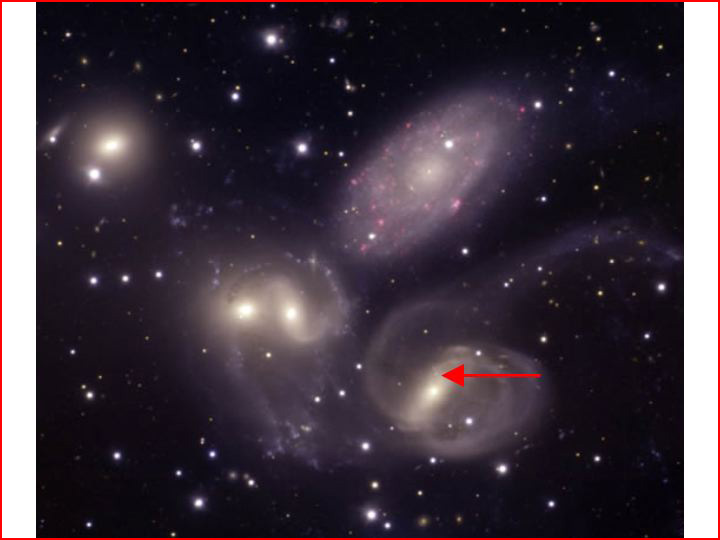|
|
||
 Credit: Gemini Observatory Image, Travis Rector, University of Alaska Anchorage |
||
|
pic of the day Links:
Society for
|
Sep 21, 2004 Photographers don't always produce an exact replica of their subjects. For example, they can use a soft focus, controlled lighting, and creative composition to highlight the best features and minimize the flaws of a family portrait. They sell a lot more pictures if they look good. This principle works for astronomers as well. The above image of Stephan's Quintet taken at the Gemini Observatory illustrates this point. The press release that goes with the image comments on the outstanding details in the photo, due to the light-gathering power of an 8-meter telescope and the clear atmosphere the night it was taken. Those who are familiar with the role of Stephan's Quintet in the redshift controversy will notice the "flaws" this photo has removed. The controversy has mostly revolved around the galaxy NGC 7320 (top galaxy in this photo). Because its redshift is much lower than the other four members of this Quintet, most astronomers believe that it is about 8 times closer to us than the other four galaxies. But there are many details of the Quintet that support the idea that all five of them are a coherent group. These are the "flaws" that have been creatively removed from this picture. First, in this picture, the HII groups in NGC 7320 are bright and reddish. The equally bright HII regions in NGC 7318 and NGC 7317 (the two interacting galaxies just below) don't show at all. This was done by selective filtering. The relative brightness and size of the HII regions in these three galaxies was one of the major arguments that all five galaxies belong together. Second, the tail of NGC 7320 has been omitted completely. It sweeps out of the picture to the right, parallel to the tail on NGC 7319 (bottom galaxy). The two tails curve together and converge on a sixth galaxy, NGC 7319C, that has been cropped out of the picture beyond the lower right-hand corner. The way the two tails interact is another argument that the whole group belongs together, rather than this one galaxy "safely isolated from the violent quarrels of the more distant cluster" as the press release puts it. The third omission isn't really omitted--it's simply ignored. There is a much bigger redshift discrepancy in Stephan's Quintet than NGC 7320, discovered October 3rd, 2003. There is a high redshift quasar buried in the dusty nucleus of NGC 7319 (red arrow above). The nucleus is opaque--nothing shines through it--and yet the redshift of this quasar indicates that it should be billions of light years beyond Stephan's Quintet. More evidence that the quasar is actually within the nucleus of the galaxy: the dust between the quasar and the center of the galaxy is energized and disturbed, with the only apparent cause the quasar itself. This discovery was officially announced in January, 2004, at the AAS meeting in Atlanta, Georgia, USA. The announcement was ignored. (The picture above was released in Sept, 2004). The paper describing the discovery has not yet been approved for publication, and may never be approved. Because if these observations are correct, it will mean the end of the most popular cosmology theory--the expanding universe and the big bang.. |
|
|
Copyright 2004: thunderbolts.info |
||
